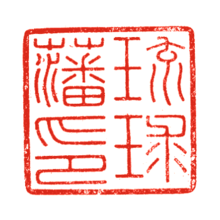Ryukyu Domain

The Ryukyu Domain (琉球藩 Ryūkyū han) was a short-lived domain of Japan, lasting from 1872 to 1879, before becoming the current Okinawa Prefecture and other islands at the Pacific edge of the East China Sea.
When the domain was created in 1872, Japan's feudal han system had developed in unique ways. The domain was a political and economic abstraction based on periodic cadastral surveys and projected agricultural yields.[1] In other words, the domain was defined in terms of kokudaka, not land area.[2] This was different from the feudalism of the West.
History

In 1609, the invasion of Ryukyu caused a change in the relationship of the island nation and Japan.[3] After 1609, the Ryukyuan kings were forced to be vassals of the Shimazu clan of Satsuma and the islands were occasionally viewed as a province of Japan.[4] At the same time, the kingdom and its rulers remained carefully independent, and also paid tribute to China.[5]
The dual nature of the kingdom and its rulers was eliminated with the creation of the Ryukyu Domain which existed from 1872 through 1879.[6] In 1872, the Emperor of Japan changed the title of Shō Tai, who was the Ryukyu Kingdom's monarch (Ryūkyū-koku-ō). Instead, Shō Tai became a domain head (Ryūkyū-han-ō). In other words, the Ryukyu Kingdom was then recognized as a han.[7] The former monarch and Ryukyuan aristocrats were granted lands and stipends of support in this period.[8] The administration of the Ryukyus was established under the jurisdiction of the Foreign Ministry.[7] After the Taiwan Expedition of 1874, Japan's role as the protector of the Ryukyuan people was acknowledged; but fiction of the Ryukyu Kingdom's independence was partially maintained until 1879.[9] In 1875, administrative jurisdiction over the Ryukyus was transferred from the Foreign Ministry to the Home Ministry.[7]
In 1879, Shō Tai was forced to abdicate and move to Tokyo, Ryukyu Domain was abolished, and Okinawa Prefecture was established.[10] Shō Tai was given the title of Marquis and added to the list of Japan's peerage.[11]
See also
Notes
- ↑ Mass, Jeffrey P. and William B. Hauser. (1987). The Bakufu in Japanese History, p. 150.
- ↑ Elison, George and Bardwell L. Smith (1987). Warlords, Artists, & Commoners: Japan in the Sixteenth Century, p. 18.
- ↑ Nussbaum, Louis-Frédéric. (2005). "Ryukyu Islands" in Japan Encyclopedia, p. 801, p. 801, at Google Books; Fassbender, Bardo et al. (2012). The Oxford Handbook of the History of International Law, p. 483; excerpt, "The status of Ryukyu is ambiguous when looked at from the perspective of modern European international law, although there appears to have been no serious issues concerning the status of Ryukyu at that time."
- ↑ Toby, Ronald P. (1991). State and Diplomacy in Early Modern Japan: Asia and the development of the Tokugawa bakufu, pp. 45-46, citing manuscripts at the Historiographical Institute of the University of Tokyo; excerpt, "Ieyasu granted the Shimazu clan the right to "rule" over Ryukyu ... [and] contemporary Japanese even referred to the Shimazu clan as 'lords of four provinces', which could only mean that they were including the Ryukyuan kingdom in their calculations. However, this does not mean that Ryukyu ceased to be a foreign country or that relations between Naha and Edo ceased thereby to be foreign relations."
- ↑ Smits, Gregory. (1999). Visions of Ryukyu: Identity and Ideology in Early-Modern Thought and Politics, p. 28.
- ↑ Matsumura, Wendy. (2007). Becoming Okinawan: Japanese Capitalism and Changing Representations of Okinawa, p. 38; excerpt, "March 27, 1879 marks the birth of Okinawa Prefecture and the death of the short-lived Ryukyu domain, which itself came into being on September 14, 1872, replacing the Ryukyu kingdom."
- 1 2 3 Lin, Man-houng. "The Ryukyus and Taiwan in the East Asian Seas: A Longue Durée Perspective," Asia-Pacific Journal: Japan Focus. October 27, 2006, translated and abridged from Academia Sinica Weekly, No. 1084. 24 August 2006.
- ↑ Matsuo, p. 81., p. 81, at Google Books
- ↑ Goodenough, Ward H. Book Review: "George H. Kerr. Okinawa: the History of an Island People ...," The Annals of the American Academy of Political and Social Science, May 1959, Vol. 323, No. 1, p. 165.
- ↑ Nussbaum, "Okinawa-ken" in Japan Encyclopedia, pp. 746-747, p. 746, at Google Books
- ↑ Papinot, Jacques Edmond Joseph. (2003). Nobiliare du Japon, p. 56, republishing Papinot (1906), Dictionnaire d’histoire et de géographie du Japon; retrieved 2013-3-23.
References
- Kerr, George H. (1958). Okinawa: the History of an Island People. Rutland, Vermont: Charles Tuttle Co. OCLC 722356
- ___________. (1953). Ryukyu Kingdom and Province before 1945. Washington, D.C.: National Academy of Sciences, National Research Council. OCLC 5455582
- Nussbaum, Louis-Frédéric and Käthe Roth. (2005). Japan encyclopedia. Cambridge: Harvard University Press. ISBN 978-0-674-01753-5; OCLC 58053128